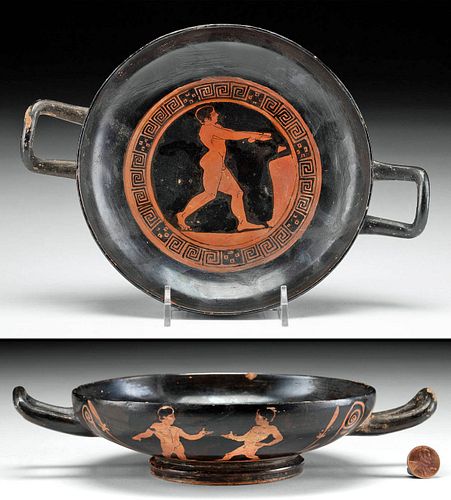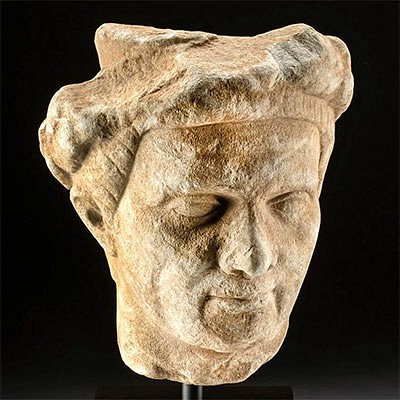Greek Attic Red-Figure Kylix w/ Nude Ephebes
About Seller
686 S Taylor Ave, Ste 106
Louisville, CO 80027
United States
Selling antiquities, ancient and ethnographic art online since 1993, Artemis Gallery specializes in Classical Antiquities (Egyptian, Greek, Roman, Near Eastern), Asian, Pre-Columbian, African / Tribal / Oceanographic art. Our extensive inventory includes pottery, stone, metal, wood, glass and textil...Read more
Two ways to bid:
- Leave a max absentee bid and the platform will bid on your behalf up to your maximum bid during the live auction.
- Bid live during the auction and your bids will be submitted real-time to the auctioneer.
Bid Increments
| Price | Bid Increment |
|---|---|
| $0 | $25 |
| $300 | $50 |
| $1,000 | $100 |
| $2,000 | $250 |
| $5,000 | $500 |
| $10,000 | $1,000 |
| $20,000 | $2,500 |
| $50,000 | $5,000 |
| $100,000 | $10,000 |
| $200,000 | $20,000 |
About Auction
Jun 1, 2023
Featuring classical antiquities, ancient, and ethnographic art from cultures encompassing the globe. Egyptian, Greek, Roman, Near Eastern, Asian, Pre-Columbian, Native American, African / Tribal, Oceanic, Spanish Colonial, Fossils, more! All legally acquired, legal to sell. Satisfaction guaranteed. Artemis Fine Arts info@artemisfinearts.com
- Lot Description
Ancient Greece, Athens / Attic, ca. 5th to 4th century BCE. A remarkable pottery kylix adorned with red-figure decoration of nude ephebes and athletes as well as geometric and vegetal designs. The central tondo features a nude male athlete in stride with arms extended as he holds a pair of halteres - dumbbells used for jumping - in his hands before a hurdle. The scene is surrounded by ring of staggered meander motifs. Alternatively, the exterior shows 2 pairs of nude athletes in discussion with one holding a strigil. The pairs are divided by 2 elaborate palmettes with vine designs, each falling beneath each upward-swooping handle. Size: 6.6" L x 9.4" W x 1.9" H (16.8 cm x 23.9 cm x 4.8 cm)
According to the Walter's Museum of Art, "Kylikes were the most common form of drinking vessel in ancient Greece. The exterior was often elaborately decorated, while the tondo in the center was revealed after the contents of the cup were consumed (the scenes were sometimes amusing as well as artistic) ...At the end of a symposium, the reveler might have used this kylix to participate in a game of kottabos, which involved flinging the dregs of his wine from his cup at a target."
Perhaps the most exciting innovation in Greek vessel painting was the red-figure technique, invented in Athens around 525 BCE and beloved by other artists of Magna Graecia. The red-figure technique allowed for much greater flexibility as opposed to the black-figure technique, for now the artist could use a soft, pliable brush rather than a rigid metal graver to delineate interior details, play with the thickness of the lines, as well as build up or dilute glazes to create chromatic effects. The painter would create figures by outlining them in the natural red of the vase, and then enrich these figural forms with black lines to suggest volume, at times perspectival depth, and movement, bringing those silhouettes and their environs to life.
Virtually no ancient Greek paintings have survived the tests of time. This makes the painted compositions found on ceramic vessels like this example invaluable sources of information about ancient Greek visual art. Refined dishes like this kylix were not merely utilitarian pottery, but rather works of art in their own right, highly prized throughout the classical world.
Provenance: private Orange County, California, USA collection acquired before 2000; ex-Arte Primitivo, New York, New York, USA, December 12, 2017, lot 282; ex-collection of Mr. and Mrs. Robert Feuer, New York, USA, acquired from the 1970s to 1980s
All items legal to buy/sell under U.S. Statute covering cultural patrimony Code 2600, CHAPTER 14, and are guaranteed to be as described or your money back.
A Certificate of Authenticity will accompany all winning bids.
We ship worldwide and handle all shipping in-house for your convenience.
#178920Condition
Professionally repaired and restored with some repainting in areas. Some small nicks and abrasions to surface, but otherwise has a very nice presentation with clear imagery and impressive detail. Old Arte Primitivo collection label on base.
- Shipping Info
-
All shipping is handled in-house for your convenience. Your invoice from Artemis Gallery will include shipping calculation instructions. If in doubt, please inquire BEFORE bidding for estimated shipping costs for individual items.
-
- Buyer's Premium



 EUR
EUR CAD
CAD AUD
AUD GBP
GBP MXN
MXN HKD
HKD CNY
CNY MYR
MYR SEK
SEK SGD
SGD CHF
CHF THB
THB












